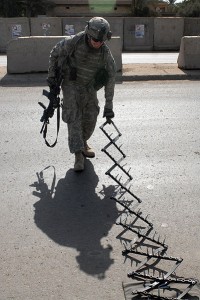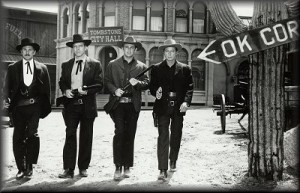If you have spent any time on this website reading posts in the Rants and Raves Logbook, you are probably aware of my personal opinions about United States policy and attendant actions in the Middle East. And if you have found any of these posts offensive, you might want to stop here.
But if you are willing to take an up-close-and-personal look at something that is eating the heart of America from the inside out, I encourage you to keep reading. And as you do, put yourself in the shoes of one man for long enough to then step back and ask yourself a few simple questions.
Is this really the America I can be proud of? Can I hold my head high to be a citizen of this once great nation? Am I content to go about my daily life and allow the flesh and blood of a few to be sacrificed on my behalf behind a wall of indifference?
If you answer “Yes” to any of those questions, God help us.
Lt. Gen. John Kelly, who lost son to war, says U.S. largely unaware of sacrifice.
By Greg Jaffe, Washington Post Staff Writer, Wednesday, March 2, 2011; 12:00 AM. Staff researcher Julie Tate contributed to this report.
Before he addressed the crowd that had assembled in the St. Louis Hyatt Regency ballroom last November, Lt. Gen. John F. Kelly had one request. “Please don’t mention my son,” he asked the Marine Corps officer introducing him.
Four days earlier, 2nd Lt. Robert M. Kell , 29, had stepped on a land mine while leading a platoon of Marines in southern Afghanistan. He was killed instantly.
Without once referring to his son’s death, the general delivered a passionate and at times angry speech about the military’s sacrifices and its troops’ growing sense of isolation from society.
“Their struggle is your struggle,” he told the ballroom crowd of former Marines and local business people. “If anyone thinks you can somehow thank them for their service, and not support the cause for which they fight – our country – these people are lying to themselves. More important, they are slighting our warriors and mocking their commitment to this nation.”
Kelly is the most senior U.S. military officer to lose a son or daughter in Iraq or Afghanistan. He was giving voice to a growing concern among soldiers and Marines: The American public is largely unaware of the price its military pays to fight the United States’ distant conflicts. Less than 1 percent of the population serves in uniform at a time when the country is engaged in one of the longest periods of sustained combat in its history.
President Obama devoted only six sentences to the war in Afghanistan in his State of the Union address in January. The 25-second standing ovation that lawmakers lavished on the troops lasted almost as long as the president’s war remarks.
Kelly has largely shunned public attention since his speech and his son’s death. He discussed his speech and his son to provide insight into the lives and the burdens of military families.
“We are only one of 5,500 American families who have suffered the loss of a child in this war,” he said in an e-mail. “The death of my boy simply cannot be made to seem any more tragic than the others.”
On Tuesday, Defense Secretary Robert M. Gates said he had nominated Kelly to be his senior military assistant, a powerful position by virtue of its minute-by-minute proximity to the Pentagon chief. He would serve as a key liaison between the defense secretary and the top brass.
As in many military families, Kelly’s two sons followed their father into the Marine Corps. The three Kelly men have participated in 11 combat tours in Iraq and Afghanistan over the past decade.
As one retired Marine Corps general noted in a condolence letter to Kelly a few days after his son’s death: “Service to and sacrifice for the nation have become a legacy affair for a relatively small number of families.”
Living on luck
A few days after graduating from Florida State University in 2003, Robert Kelly surprised his family by enlisting in the Marine Corps. His elder brother, John, had joined as an officer two years earlier. Their father was leading Marines in Iraq.
The war was something new in early 2003, and like most Americans, Robert had spent the spring glued to the live television coverage of U.S. tanks converging on Baghdad.
One year later, Robert was a private first class fighting house to house in the battle for Fallujah, the largest and bloodiest urban battle for U.S. troops since Vietnam.
On the night the offensive began, the elder Kelly came home early from work and urged his wife to steel herself for the worst. “Robert is right in the middle of it,” he told her.
Robert emerged from the three-week assault physically unscathed, but shaken by the violence. Six Marines in his 150-man company were killed, three dozen were wounded and the rest suffered a psychological toll. By this point, the war was no longer being beamed home to the United States on cable television.
“It was weird to read mail again, a reminder that other people’s lives go on while I am here,” he wrote in a letter dated Nov. 19, 2004, to his best friend from high school. “Things have not been going so well. I am having a lot of trouble dealing with this [expletive]. It is hard to explain right now. I just want to go home and see my family and friends. I really want to sit down with my dad and talk.”
Robert told his father that he was especially bothered by an incident in which his platoon was taking fire from insurgents in an underground bunker. The Marines’ interpreter screamed at them to surrender. When they continued to shoot, Robert’s unit used explosives to blow them out of the bunker.
“He mentioned that it must have been a horrible way to die,” his father recalled. “It wasn’t as clean as he thought it would be. He felt bad about the whole thing, and I told him that was human.”
In 2008, Robert moved from the enlisted to the officer ranks and was commissioned as a second lieutenant. Because his father was deployed as commander of U.S. forces in western Iraq, Robert’s brother administered the oath. The change meant Robert would be responsible for the lives of three-dozen Marines.
Robert, who inherited his father’s prominent nose, bushy eyebrows and sly smile, was seven years older than most second lieutenants and one of the few platoon leaders in his brigade with combat experience.
Before his platoon deployed last September, Robert sent a blast e-mail to his friends and family. If people were wondering what to put in care packages, batteries, wet wipes and protein bars were best, he wrote. A simple letter from home was “always welcome.”
Mostly, though, he wanted his friends and family to care about a war that had largely faded from the public’s consciousness. The midterm congressional elections were only a month away. Hardly any candidates were talking about Afghanistan. Less than 2 percent of voters rated it their top issue.
“Try to keep your eye on the news,” Robert wrote from Camp Pendleton, Calif. “It will be good to know that people are paying attention to what the 32 Marines with me will be accomplishing.”
Robert’s platoon occupied an isolated patrol base in Sangin district, an area where British forces had been losing ground to the Taliban. Soldiers and Marines at larger established bases speak to their families almost daily on cell phones. At Robert’s isolated patrol base, there was no cell phone coverage or Internet service, just “ammo and big rats,” he said in a rare letter home.
Throughout the fall, his 1,000-man battalion took part in some of the most intense fighting of the 10-year-old war, killing dozens of Taliban and slowly pushing them back. Robert’s father followed his son’s battalion over the Pentagon’s classified Internet.
“I know you guys have taken some licks in the last few days,” the elder Kelly wrote in a letter dated Oct. 15. As a platoon commander, Robert was now responsible for every patrol that left the base. Kelly knew it was an enormous burden.
“Robert, you will likely lose one or more of your precious Marines if you haven’t already,” the elder Kelly continued. “Do not let the men mope or dwell on the loss. Do not let them ever enjoy the killing or hate their enemy. It is impossible to take the emotion out of it, but try and keep it as impersonal and mechanical as you can. The Taliban have their job to do and we have ours. That’s it. Combat is so inhumane; you must help your men maintain their humanity as well as their sense of perspective and proportion.”
On the day Kelly mailed the letter to his son, Lance Cpl. Colin Faust, one of Robert’s Marines, stepped on a land mine and lost part of his left leg. The next day, a sergeant in Robert’s platoon was killed and a lance corporal lost his right arm when a land mine detonated under them.
On Oct. 19, Robert’s commanders brought satellite phones to his remote base so he and his Marines could talk to their increasingly anxious spouses. In 2007, Robert had married his girlfriend, Heather, who had asked him to a “Kappa Krush” sorority party during his senior year of college. She had stuck with him through boot camp, an Iraq tour and a seven-month sea tour in 2006. This was their first deployment as a married couple.
Robert’s call from Sangin kept being dropped, so Heather ran out to the driveway hoping for better reception. He quickly told her to call his father and ask him to check in on two of his Marines who had just arrived at the National Naval Medical Center in Bethesda.
The elder Kelly and Robert’s sister, Kathleen, had been making almost daily trips to visit Marines from Robert’s unit. Second Lt. Cameron West, one of Robert’s closest friends from his battalion, was still in intensive care when Kelly first visited him. West’s right leg was gone and his eye was bandaged shut. He had just woken after being unconscious for six days.
Heather, who had been to West’s apartment at Camp Pendleton, mentioned that he liked John Wayne memorabilia. So in late October, the elder Kelly bought him a fleece John Wayne blanket for his hospital bed.
In his last calls home, on Oct. 29, Robert sought to ease his family’s growing worry. His platoon had flown into one of the larger forward operating bases to attend a memorial service for one of his Marines who had been killed a week earlier. Robert pressed his mother and sister for updates on his Marines at Bethesda.
He even managed to reach 2nd Lt. James Byler, a good friend who had lost his legs in a bomb blast and was still in intensive care. A nurse brought a phone into Byler’s room, and Robert told him he’d soon be back doing CrossFit, a workout popular with Marines. Byler let out a groggy laugh.
Robert couldn’t reach his father but left him a brief phone message. Before he flew back to his tiny patrol base, he dashed off a final e-mail to his wife. “I always think I do not want to call you because I will be homesick, but I end up doing it and leave the phone tent with a smile on my face,” Robert wrote. “I love you so much and appreciate you being a great sport in all of this craziness. One month down and a lot of months to go, but I am doing what I want to do with my life.”
About 12 hours later, the elder Kelly e-mailed his extended family in Boston, preparing them for the possibility that Robert might be maimed or killed. Kelly knew that Robert went out on almost every patrol with his men through mine-filled fields. One of the Marines at Bethesda told him that Robert was “living on luck.”
“I write you all to just let you know he’s in the thick of it and to keep him in your thoughts,” Kelly typed. “We are doing a Novena a minute down here and there is no end in sight.”
On Oct. 31, Kelly sent a second e-mail to his eldest sister, the family matriarch. “I am sweating bullets,” he confided. “Pray. Pray. Pray. He’s such a good boy . . . and Marine.”
Fight to bring us home
At 6:10 a.m. on Nov. 9, Gen. Joseph F. Dunford Jr., one of Kelly’s oldest and dearest friends, rang the doorbell at his home in the Washington Navy Yard. The instant Kelly saw Dunford, dressed in his service uniform, he knew Robert was dead.
As a Marine Corps general, Kelly had spoken with scores of grieving parents. He had written hundreds of condolence letters. In them, he tried to explain why the loss of a beloved child was meaningful, noble and worth the family’s pain.
“I guess over time I had convinced myself that I could imagine what it would be like to lose a son or daughter,” he said in an interview. “You try to imagine it so that you can write the right kind of letters or form the right words to try to comfort. But you can’t even come close. It is unimaginable.”
Months later, Kelly would struggle to describe the pain he felt on his front porch. “It was disorienting, almost debilitating,” he wrote in an e-mail. “At the same time my mind went through in detail every memory and image I had of Robert from the delivery room to the voice mail he’d left a few days before he died. It was as graphic as if I was watching a video. It really did seem like hours but was little more than a second or so.”
Kelly composed himself and moved down his front steps to speak with Dunford’s wife and walk his friends into the house. His wife, Karen, was still asleep. “I then did the most difficult thing I’ve done in my life,” Kelly said. “I walked upstairs, woke Karen to the news and broke her heart.”
Four days later, Kelly stood in front of a microphone in St. Louis. He saw his speech there as a chance to remind people that the United States was still at war.
“We are in a life-and-death struggle, but not our whole country,” he told the crowd. “One percent of Americans are touched by this war. Then there is a much smaller club of families who have given all.”
He spoke of the anger that some combat veterans feel toward the war’s opponents. “They hold in disdain those who claim to support them but not the cause that takes their innocence, their limbs and even their lives,” he said.
Later, he clarified in an interview that he is opposed to indifference, not dissent. “I just think if you are against the war, you should somehow try to change it,” he said. “Fight to bring us home.”
Kelly’s concerns have been echoed of late by generals, lawmakers and top Pentagon civilians. “I worry that we could wake up one day and that the American people will no longer know us, and we won’t know them” Adm. Mike Mullen, the chairman of the Joint Chiefs of Staff, wrote in January.
Former congressman Ike Skelton (D-Mo.) recently lamented to Foreign Policy magazine that “those who protect us are psychologically divorced from those who are being protected.”
He’d want you to have it
In mid-February, Kelly received word that Lance Cpl. Sebastian Gallegos, one of his son’s Marines from Afghanistan, had declined to accept the Purple Heart he had earned. Gallegos’s right arm was severed in an October bomb blast that had killed his squad leader, Sgt. Ian M. Tawney, 25.
The 21-year-old Marine couldn’t fathom accepting an honor for an event that had taken his friend’s life. Gallegos was lying next to a mortally wounded Tawney as the helicopter left Sangin. “I told him I loved him and watched him die,” Gallegos recalled. A few weeks later, Tawney’s wife gave birth to a baby girl.
Kelly offered to fly to Brooke Army Medical Center in San Antonio, where Gallegos was being treated, to present the award. Gallegos told him it wasn’t necessary.
“Robert would want you to have it,” Kelly insisted over the phone.
The ceremony was held in a prefabricated building on the hospital campus. A few minutes before it began, Kelly asked Gallegos to look at a picture of Robert that had been taken on the morning he died. Robert was talking to another Marine and grimacing. “It is the only picture I can ever remember of him in which he wasn’t smiling,” Kelly said.
He wanted to get the name of the Marine in the picture and ask him why Robert was so irritated. Kelly knew his son as a happy, funny and gentle young man. Now he was trying to better understand him as the battle-hardened combat leader that he had become, he said. Gallegos passed along the name.
The ceremony began around noon. About a dozen of Gallegos’s family members took seats on leather couches facing an American flag and a red Marine Corps banner. The women all wore black dresses and heels. Gallegos’s father, a former Army Special Forces sergeant, wore a new straw cowboy hat, polished cowboy boots and a tie.
The official ceremony took about 30 seconds. Kelly and Gallegos stood facing each other at the front of the room. The young Marine looked at the ground as Kelly read the award citation and pinned the small purple-and-gold heart to his camouflage uniform. The general gripped Gallegos’s left hand and squeezed his shoulder, just above his stump. Gallegos’s wife beamed with pride.
After the ceremony, Gallegos’s family formed a huddle around their Marine. Gallegos, who had passed up a scholarship offer from Columbia University to enlist, had 12 more months of rehabilitation and then he planned to go to college somewhere in Texas. He wanted to stay close to his family, he said.
His wife wrapped an arm around his waist, put her head on his shoulder and rested a neatly manicured hand on his chest. For the first time that day, Gallegos looked happy and relaxed. He was finally enjoying the moment that he had resisted for months.
Kelly watched from across the room. “They are kids,” he whispered. “Look at them. They are just kids.”
 Does is seem unreasonable to you that the American public should expect our leaders to be responsible stewards of the billions of dollars entrusted to them? Assuming your answer to that question is, “No,” consider with me for a moment the lunacy represented by the following two egregious examples of a fiscally brain-dead system.
Does is seem unreasonable to you that the American public should expect our leaders to be responsible stewards of the billions of dollars entrusted to them? Assuming your answer to that question is, “No,” consider with me for a moment the lunacy represented by the following two egregious examples of a fiscally brain-dead system. The Commission on Wartime Contracting was established by Congress in 2008 under the model of the Truman Commission, which investigated US government spending during WWII. According to a recent study released by the Commission, corruption and waste have cost the US government billions of reconstruction dollars in Iraq and Afghanistan.
The Commission on Wartime Contracting was established by Congress in 2008 under the model of the Truman Commission, which investigated US government spending during WWII. According to a recent study released by the Commission, corruption and waste have cost the US government billions of reconstruction dollars in Iraq and Afghanistan. The report found that “criminal behavior and blatant corruption” were responsible for much of the waste related to the nearly $200 billion spent since 2002 on reconstruction and other projects in the two countries. It did not give exact figures, but cited the Inspector General for Afghanistan Reconstruction report to Congress in January that found efforts were at clear risk because of poor planning and insufficient oversight. Another estimate in the report found that losses to fraud alone in both war zones could be as high as $12 billion.
The report found that “criminal behavior and blatant corruption” were responsible for much of the waste related to the nearly $200 billion spent since 2002 on reconstruction and other projects in the two countries. It did not give exact figures, but cited the Inspector General for Afghanistan Reconstruction report to Congress in January that found efforts were at clear risk because of poor planning and insufficient oversight. Another estimate in the report found that losses to fraud alone in both war zones could be as high as $12 billion. “When it comes to oversight of contingency contracting, we’ve been driving beyond the reach of our headlights. Reforms are badly needed,” said the report. “For many years, the government has abdicated its contracting responsibilities — too often using contractors as the default mechanism — without consideration for the resources needed to manage them.”
“When it comes to oversight of contingency contracting, we’ve been driving beyond the reach of our headlights. Reforms are badly needed,” said the report. “For many years, the government has abdicated its contracting responsibilities — too often using contractors as the default mechanism — without consideration for the resources needed to manage them.” poorly, it would seem) by the State Department, Pentagon and the US Agency for International Development (USAID).
poorly, it would seem) by the State Department, Pentagon and the US Agency for International Development (USAID). According to the Government Accountability Office (GAO) February 24th report to the chairman of the House Armed Services Committee, a set of three reports submitted by the Air Force to Congress in 2010 addressing the service’s fighter aircraft structure lacked key data needed to ensure accuracy, and assumptions about developmental programs have since been proven invalid. Conclusions drawn by the Air Force “reflected previously established service plans and strategic level guidance that were dated by the time the reports were issued.”
According to the Government Accountability Office (GAO) February 24th report to the chairman of the House Armed Services Committee, a set of three reports submitted by the Air Force to Congress in 2010 addressing the service’s fighter aircraft structure lacked key data needed to ensure accuracy, and assumptions about developmental programs have since been proven invalid. Conclusions drawn by the Air Force “reflected previously established service plans and strategic level guidance that were dated by the time the reports were issued.” The original Air Force reports determined that effective management of the Joint Strike Fighter (JSF) program could mitigate the service’s projected fighter aircraft shortfall, and that extending their service life and upgrading existing fighters would be as effective as procuring new fighters at 10 to 15 percent of the cost. They also suggested that procuring so-called “4.5 generation” aircraft would not fulfill the service’s mission of converting to an all-stealth fighter fleet.
The original Air Force reports determined that effective management of the Joint Strike Fighter (JSF) program could mitigate the service’s projected fighter aircraft shortfall, and that extending their service life and upgrading existing fighters would be as effective as procuring new fighters at 10 to 15 percent of the cost. They also suggested that procuring so-called “4.5 generation” aircraft would not fulfill the service’s mission of converting to an all-stealth fighter fleet. The service had predicted that older F-16s would encounter wing cracks and other structural problems that would require them to be retired early, yet new data suggests the aircraft are salvageable. “Air Force officials have revised their projections and now believe that the wing cracking problem is not as severe as originally projected,” the GAO report states. “As a result, they believe that the near-term fighter shortfall has been mitigated without an additional investment.” The report adds that wing crack data has not yet been certified by the service’s Fleet Viability Board.
The service had predicted that older F-16s would encounter wing cracks and other structural problems that would require them to be retired early, yet new data suggests the aircraft are salvageable. “Air Force officials have revised their projections and now believe that the wing cracking problem is not as severe as originally projected,” the GAO report states. “As a result, they believe that the near-term fighter shortfall has been mitigated without an additional investment.” The report adds that wing crack data has not yet been certified by the service’s Fleet Viability Board. On the other hand, the Air Force intends to make up the fighter jet shortfall entirely through the acquisition of the F-35 Joint Strike Fighter (JSF), which has experienced significant delays and cost overruns since the Air Force reports were released a year ago. The program was reshuffled last May, when Vice Adm. David Venlet took over as JSF program executive officer, and the Air Force is now planning to acquire fewer F-35s than anticipated in the short term. The GAO report states that the Air Force needs a fully updated JSF baseline in order to make “better-informed aircraft investment decisions.” More information on the cost of maintaining existing fighter aircraft versus procuring new F-15s and F-16s is also necessary to validate the Air Force reports, according to GAO.
On the other hand, the Air Force intends to make up the fighter jet shortfall entirely through the acquisition of the F-35 Joint Strike Fighter (JSF), which has experienced significant delays and cost overruns since the Air Force reports were released a year ago. The program was reshuffled last May, when Vice Adm. David Venlet took over as JSF program executive officer, and the Air Force is now planning to acquire fewer F-35s than anticipated in the short term. The GAO report states that the Air Force needs a fully updated JSF baseline in order to make “better-informed aircraft investment decisions.” More information on the cost of maintaining existing fighter aircraft versus procuring new F-15s and F-16s is also necessary to validate the Air Force reports, according to GAO. The Air Force estimated it would cost $9 million to modernize and upgrade existing F-16s, which would extend their life cycle an additional 2,000 flight hours ($4,500 per additional hour). In contrast, procuring a brand-new F-16 with a projected life cycle of 8,000 hours would cost $55 million ($6,875 per hour). It’s a straightforward question: Does spending $2,375 more per hour for a new F-16 make sense?
The Air Force estimated it would cost $9 million to modernize and upgrade existing F-16s, which would extend their life cycle an additional 2,000 flight hours ($4,500 per additional hour). In contrast, procuring a brand-new F-16 with a projected life cycle of 8,000 hours would cost $55 million ($6,875 per hour). It’s a straightforward question: Does spending $2,375 more per hour for a new F-16 make sense? The answer, however, is a bit more complicated because GAO calculations compared to those of the Air force show a narrower gap between the cost per additional flight hour for the two options under consideration. The GAO numbers indicate that modernizing existing systems would be significantly more efficient than procuring new fighter aircraft. Even so, after all this reporting going on, we should be able to reconcile the data and come to an informed decision, right?
The answer, however, is a bit more complicated because GAO calculations compared to those of the Air force show a narrower gap between the cost per additional flight hour for the two options under consideration. The GAO numbers indicate that modernizing existing systems would be significantly more efficient than procuring new fighter aircraft. Even so, after all this reporting going on, we should be able to reconcile the data and come to an informed decision, right? Wonderful. That must foretell another report. And in the midst of this fiasco, an even more significant issue sits like the 500-pound gorilla in the room: the GAO report only addresses the option of purchasing new F-16s rather than upgrading older ones. The current reality is far more troublesome. We have committed to retiring all F-16s and F-15s and replacing them with the F-35 JSF, the most expensive single military procurement package in US history, way over budget and way behind schedule.
Wonderful. That must foretell another report. And in the midst of this fiasco, an even more significant issue sits like the 500-pound gorilla in the room: the GAO report only addresses the option of purchasing new F-16s rather than upgrading older ones. The current reality is far more troublesome. We have committed to retiring all F-16s and F-15s and replacing them with the F-35 JSF, the most expensive single military procurement package in US history, way over budget and way behind schedule.










































